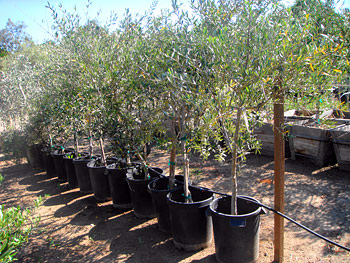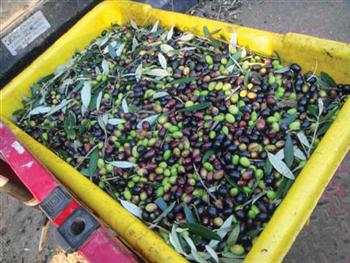Varieties of Olives
What We Carry:
| TUSCAN | GREEK | SPANISH | FRENCH |
| Swan Hill Favolosa Frantoio Leccino Pendolino Coratina Cerignola |
Kalamata | Sevillano Manzanillo Arbequina |
Cayon Luc Picholino |
Reach us at 707-732-6152 to inquire about any of these varieties.

Frantoio
Frantoio is the most noted olive oil variety of Tuscany, Italy, and one of the most highly acclaimed oil varieties in the world. It is grown commercially in most olive growing regions including California. This variety has provided high percentages of very high quality oil to processors for many years. Italian sources list the oil content of Frantoio at between 21% and 23 %. Growers seeking a true Tuscan flavor find it is achieved with this cultivar.
However, Frantoio not a very vigorous grower and maintenance is essential because it needs to be pruned with meticulous care. The variety is self pollinating with high, constant productivity. For growers choosing pollination, the recommended pollinators would be Pendolino, Maurino, or Leccino. The tree is early-season in fruit-set and produces a heavy crop ready for oil harvesting in the mid-to-late season.
The fruit ripens gradually which allows a longer harvest window than faster-ripening varieties; when mature the fruits are purple-black. The preferred harvest time for oil production occurs when the olive is green to purple-green. The oil is of fruity character, highly aromatic and of leading quality.
Frantoio trees are fast-growing and have been proven to crop well in many parts of the world ranging from the cold of Tuscany, Italy to warmer regions. It is not a good producer in areas with fog or cold windy areas. Also, it has been proven to be one of the best varieties to plant in marginal and tough conditions such as soils with a high percentage of clay or rocks.
Manzanillo
This is a common variety for table olives and caning – generally used for pickling due to the texture of the flesh – and is seldom used in the process of making olive oil. On average, the oil content is in the 16% to 18% range and some producers use it as varietals. While the amount of oil available is low, its flavor is highly desired by some.
The tree has a low, spreading habit and while it is similar to many olives in that it can grow up to ten meters tall, most Manzanillo trees stay at around five meters for ease of management and harvesting. With normal cultural care Manzanillo is a regular annual bearer with the fruit maturing early in the season. It has cropped well even in warm winter areas with little or no frost. The oil from this variety has the rich green color and abundant flavor characterizing the fall harvest varieties, combined with a slight tartness that can add distinct flavor to a variety of foods.
 Mission
Mission
The Mission Olive was introduced into California in the mid-late 1700’s as a staple of the California Missions. It produces a small fruit considered by many as a good candidate for pickling, yet is still sought after for its oil.
The tree will fare better in warmer areas; it tolerates cold except in areas with damp cold air as found along the coast. The Mission Olive produces fruit for harvest in November after the majority of other varieties; this gives growers the ability to harvest more olives within a more controlled environment.
Swan Hill
Because of the recent concern for the rising volume of pollen some communities prohibit the planting of olive trees however often the Swan Hill is not subject to these prohibitions. Research conducted at the University of Arizona, Tucson, AZ, and the University of California, Davis, CA showed that the Swan Hill Olive releases less than 1% of the pollen released by common European Olives. On the basis of this research The Swan Hill Olive has been granted exemptions from olive planting prohibitions in most if not all communities.
The growth rate of the non-fruiting Swan Hill Olive is considered to be “moderate” and can be planted in both lawn and desert adapted landscape design. Generally a Swan Hill does not tolerate saturated soils, especially within the first 6 to 12 months following transplanting. Be sure and keep the area under the tree (out to the drip line) clear of grass when planting on a lawn. Similarly, the area beneath the drip line should not be over seeded with winter rye grass for 6 to 12 months following transplantation.
Another excellent choice for this tree is around picnic and swimming pool areas. Since there is no fruit to worry about the mess associated with olive trees is eliminated, plus with maturity it will produce a fantastic canopy for those hot days when you need some shade.
The absence of fruit production in the Swan Hill Olive means the tree can use all of the nutrients, energy, and water for upward and outward vegetative growth all year, every year. It is not unusual to see an average growth rate of two feet plus per year under ideal conditions within for the first 10 years following planting.
Carefully pruned multiple trunk Swan Hill Olives usually reach a mature height of 30 feet by 20-30 feet wide. Under ideal conditions they can easily grow to 35 foot tall by 30 wide in 10-15 years following planting (depending upon the original box size and climate in the area the tree is planted).
Pollinators
The majority of olive cultivars are self fertile and therefore do not need cross-pollination by other cultivars. However, a number of sources recommend pollinators such as Pendolino, Maurino, and Leccino to increase the yields of certain cultivars. In general, most researchers are now recommending that growers plant at least three olive varieties in close proximity in their groves to ensure some cross-pollination.
On this point there is considerable debate when it comes to actually producing oil from one type of tree vs. blending of oils from a variety of trees. True Tuscan oil is made from a blend of because a single source cannot provide the intensity and interlacing flavor available with a blend of olive oils. Another argument used by growers in the favor of multiple tree orchards is due more to belief and understanding that the characteristics of an oil is controlled more by the distinct time period of harvest than any other single characteristic.